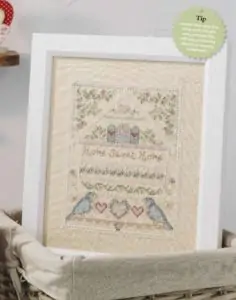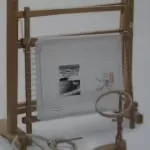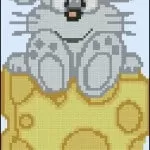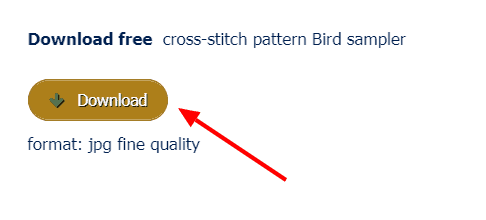Our feathered friends have been a favourite subject of embroiderers for centuries. To give this cross stitch pattern an old-world feel, DMC designed it to be stitched on vintage Zweigart linen which has a tea-dyed effect.
MATERIALS
• 60cm x 47cm (24in x 18‘hin) rectangle o f Zweigart
32-count vintage Belfast linen (3609.140.3009)
• DMC Stranded Embroidery Cotton: 1 skein each of very dark shell pink (221), very dark baby blue (312), medium
baby blue (334), drab brown (611), very light old gold (677), medium old gold (729), ultra very dark topaz (780),
light golden olive (833), dark antique blue (930), light antique blue (932), medium yellow beige (3046), black
brown (3371); 4 skeins of medium mustard (370)
• No 24 tapestry needle
• Embroidery hoop (optional)
• Contrasting sewing thread
• Rider and pencil
FINISHED SIZE
Design area: 45cm x 32cm
(18in x 13in)
STITCH USED
Cross stitch
PREPARATION
Read through the instructions before you begin. Iron the fabric carefully, then overlock or zigzag- stitch the edges to prevent it from fraying.
Find the middle of the fabric either by measuring, or by folding it in quarters and marking the folds with lines of tacking stitches in contrasting machine- sewing thread. These tacking stitches should be the length of 20 linen threads and they help with counting the stitches against the chart. The lines intersect in the centre.
Use a ruler to draw lines between the two or four arrows on the edges of the chart to give you the design centre. The middle of the fabric corresponds to the centre of the chart. Each square on the design chart represents a cross stitch and each symbol denotes the colour thread to use.
STITCHING
Always begin stitching at the centre of the design. It is important that the upper stitches lie at the same angle.
To begin, select a colour and separate the strands of the cotton to let them untwist, then put them back
together to thread the needle. Hold the loose end behind the fabric and catch it down with your first stitches.
To end off the thread, run the needle through the back of several stitches to secure it. Don’t knot the end of
the thread as this leaves a ridge in the fabric on the finished work.
Also, avoid carrying threads across to
different areas of the design as it may show through on the front.Keep the tension even without pulling the thread too tight. Working in an embroidery hoop or lap frame helps maintain it. If you do use a hoop, however, take your work out of it when you’re not stitching as leaving it in place makes creases in the fabric that can be difficult to get rid of. Work the cross stitches in two strands of embroidery cotton. Each stitch on the graph covers two linen
threads in each direction.
FINISHING
Once you’ve finished the stitching and taken out the tacking, it is a good idea to wash it. Dissolve pure soap flakes in warm water and swish the fabric gently through the suds without rubbing it. Rinse it thoroughly in cold running water, then roll it carefully in a clean white towel to absorb the moisture. Don’t wring it either – simply lay
it out flat in the shade until it’s almost dry. Then put it face down on a fluffy white towel and press it with the iron on a warm setting. Avoid putting pressure on the iron, however, as this tends to flatten the stitches. Your work is now ready to be framed.
Download free cross-stitch pattern Bird sampler
Downloadformat: jpg fine quality











Klick on the button “Download”
Help!! I can not download the pattern
Dear Nancy! I sent you an email the pattern
Unable to download Bird Sampler pattern. Please email
Dear Charla! There are 4 jpg files in the archive that show the whole pattern. You should read them in this order – first row: 067, 064, second row: 066 and 065. Print them out and glue them together in this order and you will get the whole pattern.
I downloaded this pattern, but the chart is missing rows (both horizontal and vertical) where the pages join . Also, some of the color symbols are so faint, you can’t really make them out. I love this pattern and have already put in a lot of time stitching. Hopefully, there is a better scan or pdf file that isn’t missing the chart where the pages join? Thanks!!
I can’t get the file to open are you able to send an email!
Hi, Sharon! I sent you an email the pattern
Can’t download free bird sampler pattern. Can you please send it to me via my email address.
download the file with the pattern, on the first page there is a small table with the deciphering of colors
I can’t seem to find the instructions for which colors to use for the different symbols depicted on the chart. Can you help?